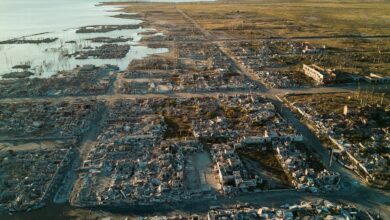The concentration of CO2, a planet-warming greenhouse gas, set a new record in 2016, according to a report by the U.N. World Meteorological Organization.
The year-to-year spike in CO2, from 400 ppm in 2015 to 403.3 ppm in 2016, also represents the biggest annual jump on record, some of which can be attributed to the 2015-2016 El Nino.
The atmosphere has as much CO2 in it as it did 3 to 5 million years ago, the report states, when “the Greenland and West Antarctic ice sheets melted and even some of the East Antarctic ice was lost, leading to sea levels that were [33 to 66 feet] higher than those today.”
The report starts out:
The rate of increase of atmospheric carbon dioxide (CO2) over the past 70 years is nearly 100 times larger than that at the end of the last ice age.
That in itself is alarming. But here’s the kicker — and the thing that may end up being more important than the total amount of CO2 in the air:
As far as direct and proxy observations can tell, such abrupt changes in the atmospheric levels of CO2 have never before been seen.
The overwhelming majority of relevant scientists agree that’s a problem.
Prior to the industrial revolution, when fossil-fuel-burning technologies started to come online, global concentration of CO2 was around 280 ppm. In just 100 short years — the blink of an eye, geologically — that level surged above 400 ppm. Burning fossil fuels takes carbon out of the ground and injects it into the atmosphere, where it prevents Earth’s heat from radiating back into space. It’s led to a 40 percent increase in the radiative forcing, or “warming effect,” of our climate.
We simply don’t know how Earth is going to respond to such a rapid increase in temperature. There is no precedent we can look to that could provide insight on how ecosystems will or won’t adapt. The closest analog we have is something that happened 55 million years ago: an era scientists call the PETM — paleo-eocene thermal maximum — in which CO2 climbed to record levels over tens of thousands of years. You can see, it doesn’t hold a candle to the rate we’re witnessing in the 20th and 21st centuries.
The increase in greenhouse gas has caused the planet to warm close to 1.5 degrees Celsius since the industrial revolution. It seems small, but it’s significant. The Paris Agreement pointed to 2 degrees as the point at which Earth’s climate may become truly inhospitable for current life — with heat waves, drought, sea-level rise and catastrophic flooding as the main impacts. The agreement basically says staying below that threshold is how we can avoid the most harm.
“Without rapid cuts in CO2 and other greenhouse gas emissions, we will be heading for dangerous temperature increases by the end of this century, well above the target set by the Paris climate change agreement,” WMO Secretary-General Petteri Taalas said in a statement. “Future generations will inherit a much more inhospitable planet.”
[adrotate banner=”69″]Washington Post

 Ruyi Bridge: The spectacular wave bridge in China
Ruyi Bridge: The spectacular wave bridge in China The sunken holiday paradise that resurfaced
The sunken holiday paradise that resurfaced The most livable city in Italy for 2024 has been chosen
The most livable city in Italy for 2024 has been chosen Bluefin tuna: Sea giant returns to the North Sea
Bluefin tuna: Sea giant returns to the North Sea